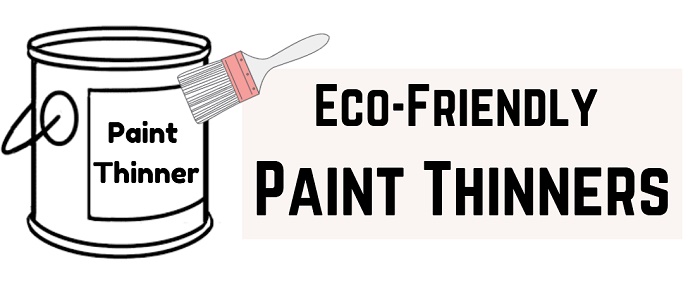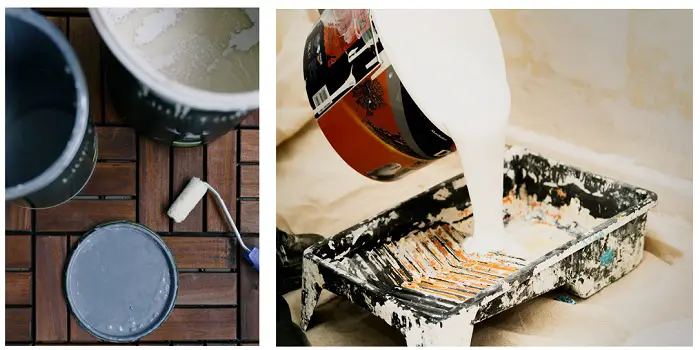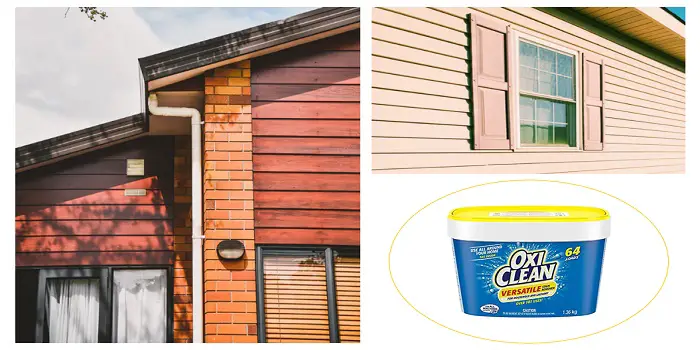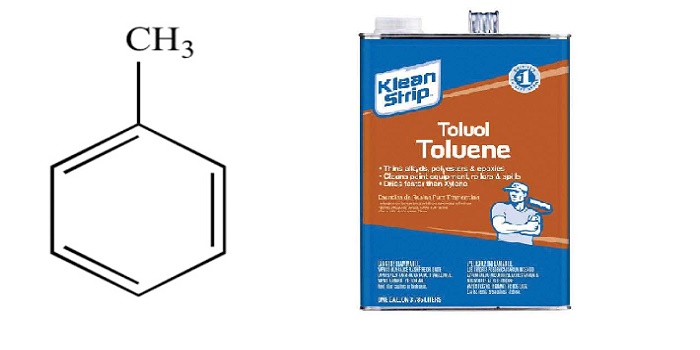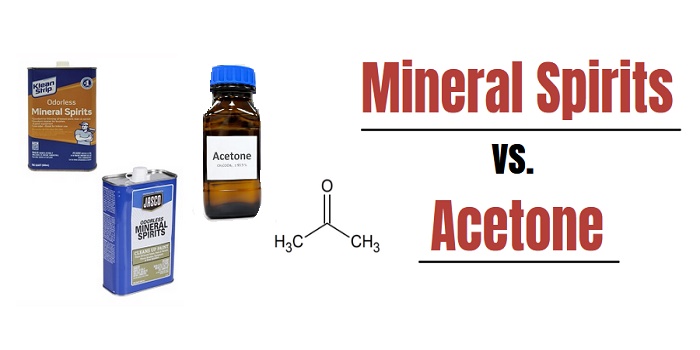
Mineral spirits and acetone are the two most widely used solvents when it comes to handling DIY home cleaning projects.
When comparing mineral spirits vs. acetone, you may wonder why to choose one over another and what are the basic differences between both.
Or, if you think whether acetone and mineral spirits are the same or two different things, let me tell you they are not similar.
While mineral spirits will only help you clean fresh paints, acetone is harsher and can aggressively strip old dried paints very easily off the surfaces.
As a thinner, both of these solvents are used to thin different products.
Where mineral spirits are generally used to thin oil-based paints, acetone can efficiently thin lacquers such as nail polish.
Mineral Spirits vs. Acetone Comparison Chart
| Mineral Spirits | Acetone |
|---|---|
| Ideal for paint thinning | Ideal for paint stripping |
| Not effective for cleaning dry paints | Can also remove old dried paints |
| Available in an odorless variety | Possess strong odor |
| Less dangerous than acetone | Highly flammable and hazardous |
| Oil-based and Not water-soluble | Water-soluble and evaporate quickly |
What's Here in the Article:
What are Mineral Spirits?
Put simply, mineral spirits are made from petroleum, and it’s a highly refined form of paint thinner, a liquid chemical used for cleaning and thinning paints.
You can call paint thinner mineral spirits.
But it is in a less pure form as it is blended with other solvents making it smell grosser and producing a very unique, strong fragrance.
Often also called Stoddard solvent, white spirit, mineral turpentine, turpentine substitute, and petroleum spirits, you can use this fine petroleum-derived clear liquid to thin oil-based paints and varnishes.
Plus, to wipe out paint from paintbrushes and other painting tools.
Though you may not use it frequently as a disinfectant spray, the mineral spirits are very effective in managing some of the most difficult messes of your house, backyard, and garage.
What is Acetone – What is it Made Of?
Acetone (also called nail polish remover) is a colorless clear liquid solvent that evaporates very quickly.
It’s sometimes also used as a common household cleaner and as a solvent to dissolve paints and varnishes.
The liquid is highly flammable and is also used as a cleaner in various industrial settings.
Acetone is produced from the raw materials of benzene and propylene.
The most common elements that compose acetone are carbon, hydrogen, and oxygen. And its chemical formula is (CH₃)₂CO.
You will be surprised to know that acetone is also a natural compound that is found in traces in plants, trees, and our bodies (in body fat).
You will also find the compound as an ingredient used in everyday items like paints, adhesives, shoe polishes, and various other cleaning products.
When using acetone and mineral spirits as a DIY cleaning agent in our home, the idea is to know what to use it on and how!
So, before we look into how to use mineral spirits and acetone, let’s know for what purposes you can use them.
Different Uses of Mineral Spirits and Acetone
Majorly used as paint thinner, mineral spirits is a cost-effective petroleum distillate- that also functions as a universal cleaner.
You would like to keep mineral spirits near you if you are going to handle a painting project, and it also helps you to clean tools, wipe out sticky remnants and make your furnishings and floor look their best.
Some of how you can use mineral spirits and acetone in your home are as given below:
1- Thin paint
You can use mineral spirits to thin all oil-based paint and get your preferred consistency.
Keep in mind, that latex and water-borne paint may separate when mixed with mineral spirits. So, do not use it to thin water-based or acrylic paints.
If you are painting a big surface, say a wall, it’s good to mix the oil paint and mineral spirits in your painting bucket.
However, if it is a small surface, such as touch-ups on furniture, then blend paint and solvent on a palette or bowl.
Usually, it is recommended to use one-part mineral spirits with three parts of paint.
But if you want a little transparent finish, then increase the number of mineral spirits.
2- Get rid of paint spills
If you have spilled oil-based paint on your floor, carpet, or any other surface – just wet a cloth with mineral spirits and wipe it away before the paint dries.
If it has dried, then you will need to put some elbow grease as the stain will then clear with some scrubbing.
With that said, you can easily remove the paint (wet or dried) from hard floors such as tile, laminate, linoleum, or wood without a wax touch-up with mineral spirits.
However, before starting, do a test to ensure that the solvent causes no damage to your floor’s finish, and use mineral spirits as little as you can to get the task done.
3- Clean brushes and other painting tools
Mineral spirits can easily wipe out oil-based paint from brushes and rollers after the job is done, preferably before the paint completely dries.
You just need to fill mineral spirits in a small container and put the painting brushes, rollers, or other tools up and down.
Allow the paint to completely get out by lightly squeezing the brush and rollers against the walls and bottom of the bowl.
If the paint has dried, then use a paintbrush comb to loosen it gradually.
Dip until the paint is removed completely and then dry the excess mineral spirits with the help of a clean cloth and then allow the brush to air dry before you store it.
4- Degrease automobile parts
Auto lovers and cyclists who perform their repairs love mineral spirits because of the speedy service they offer in removing dirt, grease, and oil build-up on engines or bike chains.
For small spare parts, dip the metal piece in a container filled with mineral spirits to loosen oil build-up and remove the residual grime using a scrub brush.
You can even clean big automotive spare parts which cannot be quickly dipped with a rag soaked in mineral spirits or acetone.
After the grease is gone, clean the leftover solvent with a dry rag and continue with the rest.
5- Make your garden tools shiny
If your loppers and gardening saw have become sticky with sap, you can remove them by dipping them in a container full of mineral spirits or acetone solvent.
If the metal tool is very big, wipe it with mineral spirits dipped cloth. After the sap is removed, use a dry rag to remove excess solvent.
Remember, acetone acts as an aggressive cleaner, and the good thing is it doesn’t leave any oil film behind like mineral spirits do in most cases.
And that’s the reason acetone is also found useful in industrial cleaning of metal pipes and metal surfaces prior to welding.
6- Get rid of scuff marks on your floor
As with paint spills, you can clean the scuff marks and scratches on your shiny hardwood floors with mineral spirits or acetone.
Remember, it will not remove the marks completely but can make them less noticeable.
Before you cast out ugly black scuff marks on your vinyl, tile, laminate, wood, or linoleum floors, do a patch test with mineral spirits in a hidden spot to make sure it causes no harm to the floor finish.
If nothing happens, rub the scuff with a mineral-spirits-soaked rag till the mark disappears.
Then wipe the excess residue with a wet cloth and some drops of dish soap.
7- Clean and restore antique wood furniture
One good advantage of acetone and mineral spirits is you can use them on unpainted wood furniture to make them look shiny.
You can also use it safely on wood with a transparent finish such as varnish, shellac, lacquer, or polyurethane.
But first, do a patch test in a hidden spot to ensure that it doesn’t cause any damage to the furniture.
Then wet a clean cloth with it and buff away the grime in a circular manner across the wooden surface.
After all the grime is removed, use a clean cloth to buff the wood till its luster is restored, and then apply a protective wax coat if needed!
8- Remove sticky price tags remnants
Maybe you want to remove the annoying residue of price tags from your new dishes, clothes, toys, or any other items.
Just pour some acetone or mineral spirits on a rag or paper towel and rub over the glue residue off the surface.
Once it is done, wipe gently using a dampened cloth or wash it with warm soapy water.
Many people like to use acetone rather than mineral spirits for sticky glue because mineral spirits are oil-based and can often leave behind a residue even after a clean-up.
Note: Do not use mineral spirits or acetone on plastics as it can dissolve and eat through plastic material leaving the item damaged forever.
How to Use Mineral Spirits and Acetone Correctly?
When using mineral spirits or acetone for your cleaning project, first, ensure that the surface you are going to use it on is cleaned well and all the dirt or grime is removed.
After you have cleaned the surface, make sure you are wearing proper safety gear like protective glasses, gloves as well as a face mask for protection against harmful fumes that can be emitted.
Now follow these steps…
- Pour some acetone/mineral spirits on the cloth, keeping in mind that a small quantity of it will go a long way.
- Rub the dampened cloth over the surface smoothly to ensure that the surface is being covered fully from one corner to another
- No matter what, do not scrub the surface hard as it may leave the surface damaged and paint to peel
When all is done, take a dry cloth and rub it over the item.
This is done to remove all the residual paint thinning solvent because if left on the surface, it may cause damage.
How to Dispose of Acetone and Mineral Spirits Rags?
Apart from being hazardous to breathe, several other environmental risks are linked with mineral spirits and acetone disposal.
First of all, anything with mineral spirits or acetone solvents can combust and is instantly inflammable.
Thus, the cloth or a piece of rag you used to polish and clean wood furniture or paintbrushes should not be reused and should be thrown away carefully.
However, you cannot just throw the cloth in the trash. Instead, you can completely soak the mineral spirits rag in water.
Fill a can with water and lock the mineral spirits dipped cloth inside before you find it safe enough to dump.
A toxic waste facility can be another good option for you to responsibly dispose of your mineral spirits rags without infecting the groundwater and environment.
Follow the rules before disposing of solvents.
The residual solvent should always be stored in a well-sealed container (majorly in the one it came in), and make sure you don’t dispose of it down any drain.
It is essential to dump acetone, and mineral spirits waste properly as it is toxic and has effective disposal rules and regulations.
You can call your local city commissioners and council office to know when your locality is hosting a waste disposal event.
They are free of cost, sponsored by local businesses, and a good option to dump mineral spirits and other toxic paint materials in an Eco-friendly manner.
Related Questions
Is mineral spirits the same as paint thinners?
Mineral spirits are of a good standard, but lower quality paint thinner is a cheaper option with regard to price.
However, it is important to know that mineral spirits are a better-quality product in comparison to paint thinners and even kerosene.
You will need less volume of it because of its strength and refinement.
So, a bottle of it will last almost a lifetime.
Kerosene, as I feel, has a little oiliness that can be utilized for cleaning and “conditioning” natural bristle brushes. But not as a paint thinner.
Can you test for latex paint with acetone?
Latex paints can be tested easily using acetone because the solvent softens the paint easily.
But it isn’t very strong to soften alkyd paints.
- Take a cotton swab or a rag dabbed in acetone
- Rub the painted surface gently
- If the swab shows some paint color, its latex paint
- If you see no color on the swab, it’s an alkyd enamel paint
What can you use as a substitute for acetone?
Although mineral spirits are a good alternative to acetone, a few other substitutes can be used safely instead of acetone.
Some of these non-hazardous, biodegradable alternatives include:
- Bio-Solv
- Surfasolve
- Replacetone
- Methyl Acetate
Final Thoughts
Acetone and mineral spirits both work very well for cleaning and paint stripping.
However, each one comes with its own uses and features along with advantages and disadvantages.
You should better choose mineral spirits when you want to thin paints for your sprayer machine.
However, acetone may work better for removing old stubborn paints or cleaning dried paint tools.
If you need, you can even mix both to create an effective paint stripping formula for old metal furniture.
Based on all these discussions and the benefits offered, choose the one that suits your purpose well, is easy to work with, and creates less mess.
Share the post "Mineral Spirits vs. Acetone – What’s Better for Cleaning?"

Douglas Becker (aka Painter Doug) has over twenty years of experience as a painter in Adkins, Texas. At present, he resides in Florida with his family.
From painting multi-storeyed houses, condos, and apartments to large commercial buildings and small offices, he had served various customers in areas not only in Adkins but also in Southwest Florida, Sarasota, Naples, and many more. To know more about him check here.

